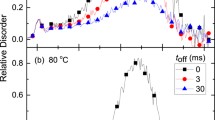Abstract
In this work, we develop a model describing the diffusion of vacancies and self-interstitials and their recombination during ion implantation. The model includes the effect of the moving surface due to regrowth and the defect generation rate as a function of depth based on Monte Carlo simulations. The results are compared to experimental measurements of the damage-to-dose ratio (DDR) after low energy, 40 eV, silicon ion implantation into silicon at 300 and 685 K. We have derived an analytic approximation which agrees with the results of the computational model, implemented on a CM-2 parallel computer. We find that the calculated effective diffusivity, the main adjustable parameter in the simulations, is much lower than predicted based on extrapolation from experiments at higher temperatures. We attribute this difference to the aggregation of self-interstitials. We also find that the effect of interstitial-vacancy recombination on DDR is negligible under the experimental conditions considered; however, the crystal surface motion has a significant impact on the results.
Similar content being viewed by others
References
N. Herbots, B.R. Appleton, T. S. Noggle, R.A. Zuhr, and S.J. Pennycook, Nucl. Instrum. Methods B13, 250 (1986).
N. Herbots, O. C. Hellman, P. A. Cullen, and O. Vancauwenberghe, in Deposition & Growth: Limits for Microelectronics, edited by G.W. Rubloff (AIP, New York, 1988), Vol. 167, p. 259.
J. P. Biersack and W. Ecstein, Appl. Phys. A34, 73 (1984).
O. Vancauwenberghe, N. Herbots, and O. Hellman, J. Vac. Sci. Technol. B 9, 2027 (1991).
The Connection Machine System (Thinking Machines Corporation, Cambridge, MA, 1991).
E. A. Volkov, Chislennye Methody (Numerical Methods) (Nauka, Moscow, 1987).
A. A. Samarsky, Vvedenie v Chislennye Methody (Introduction to Numerical Methods) (Nauka, Moscow, 1987).
V.l. Smirnov, Kurs Vysshey Matematiki (Course of High Mathematics) (Nauka, Moscow, 1974), p. 642.
T. Y. Tan and U. Gösele, J. Appl. Phys. A37, 1 (1985).
Author information
Authors and Affiliations
Rights and permissions
About this article
Cite this article
Levin, Y., Herbots, N. & Dunham, S. Damage-to-dose ratio after low energy silicon ion implantation into crystalline silicon. Journal of Materials Research 8, 2305–2309 (1993). https://doi.org/10.1557/JMR.1993.2305
Received:
Accepted:
Published:
Issue Date:
DOI: https://doi.org/10.1557/JMR.1993.2305




